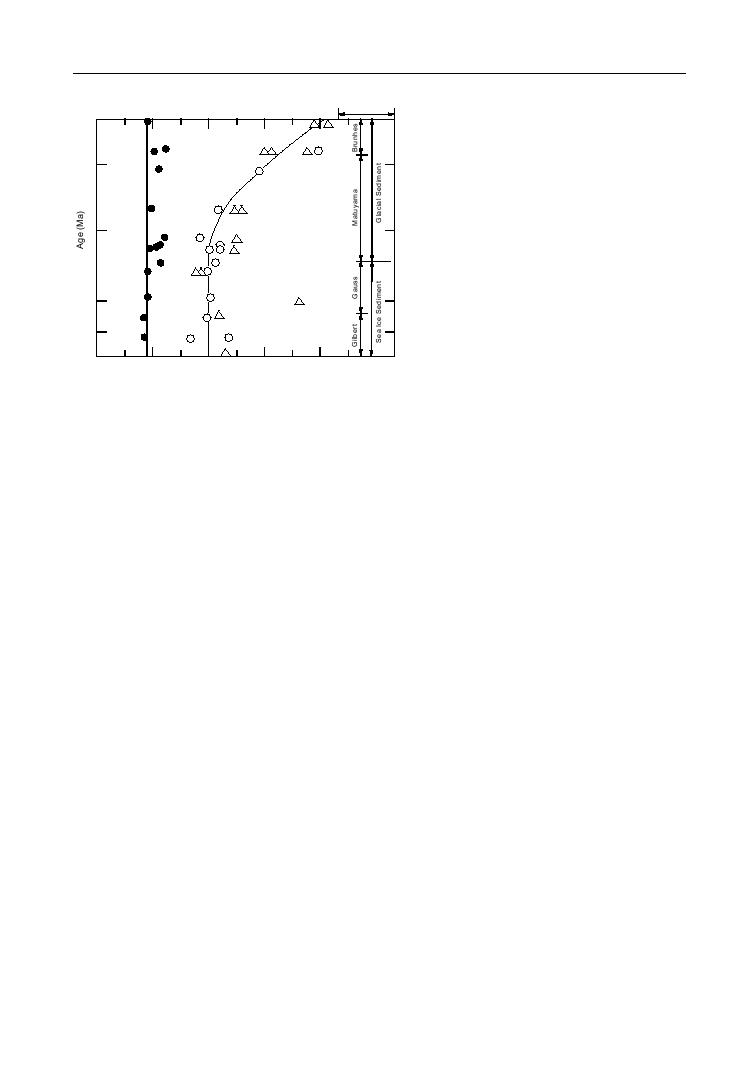
1994 Arctic Ocean Section
500x
Analytical Precision
other sediments that have been analyzed.
0
This is consistent with the high concentra-
Seawater
tions of smectite in this region and indi-
1
cates that the extensive Mesozoic basalt
Oxide
Silicate
complexes of the adjacent continental land
Fraction
Fraction
mass are important sources of sediment to
this shelf region. However, these rivers and
2
the Kara Sea shelf in general cannot be im-
portant sources of sediment for the central
Arctic Ocean.
3
Late Cenozoic sediments on the Alpha
Ridge in the central Arctic Ocean (~5 m
4
thick) were deposited at very low sedimenta-
5
0.705
0.710
0.715
0.720
0.725
tion rates (~1 mm/ky) and can be separated
87
86
Sr/ Sr
into two distinct sedimentary packages based
Sr isotope varia- on lithology. The lower package (~52.4 Ma) is composed of silty lutites that
tions of components
of Late Cenozoic are interpreted to have been deposited by sea ice. The upper sedimentary pack-
sediment from the age (~2.40 Ma) is composed of alternating sandy and silty lutites and has
Alpha Ridge, central glacial dropstones occurring throughout the sequence. The younger cyclic se-
Arctic Ocean. The
components that quence is interpreted to have been deposited by glacial ice; the coarse layers
were analyzed in- were deposited during glacial maxima and deglaciation, whereas the fine in-
clude the oxide frac- tervals were deposited during interglacial periods. We have analyzed detrital
tion of ferromanga-
nese micronodules silicate material, planktonic foraminifera and the diagenetic (oxide) fraction of
(solid circles), the ferromanganese micronodule (50300 m) separates throughout a composite Late
silicate fraction of
Cenozoic sedimentary sequence for variations in Nd, Sr and Pb isotopes and rare
ferromanganese mi-
earth elements. The oxide fractions of FeMn micronodule separates were iso-
cronodules (open
circles) and bulk sili- lated using a chemical reductant. The foraminifera and the diagenetic frac-
cate sediment
tions record the isotope variations of Arctic seawater.
(open triangles).
The Sr, Nd and Pb isotope compositions of the siliciclastic fraction are
homogeneous during the time of sea ice sedimentation (~52.4 Ma), whereas
87Sr/86Sr and 206Pb/204Pb ratios progressively increase and 143Nd/l44Nd ratios
decrease during the time of glacial sedimentation. We interpret these isotope
variations to indicate a progressive change in the source of sediments to the
central Arctic Ocean beginning at the time of initiation of continental glacia-
tion (~2.4 Ma). All the isotope systems are remarkably consistent and indicate
that the sediment source region during glacial sedimentation (~2.40 Ma)
had a greater supracrustal component and/or an older average age relative to
the source that supplied sediment during the time of sea ice sedimentation
(~52.4 Ma). The isotope data are consistent with derivation of the older
(~52.4 Ma) sediment entirely from the Siberian shelf, whereas the Canadian
Island region became a progressively more important source of sediment since
~2.4 Ma. The general increase in the amount of coarse sediment since ~2.4
Ma is consistent with this hypothesis. We intend to further refine and sub-
stantiate sediment source regions by analyzing circum-Arctic river and shelf
sediments for isotope variations.
96



 Previous Page
Previous Page
